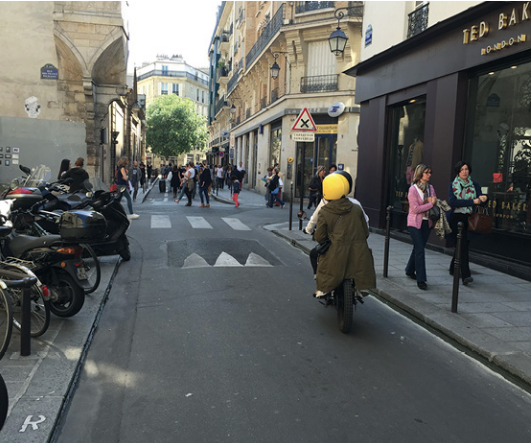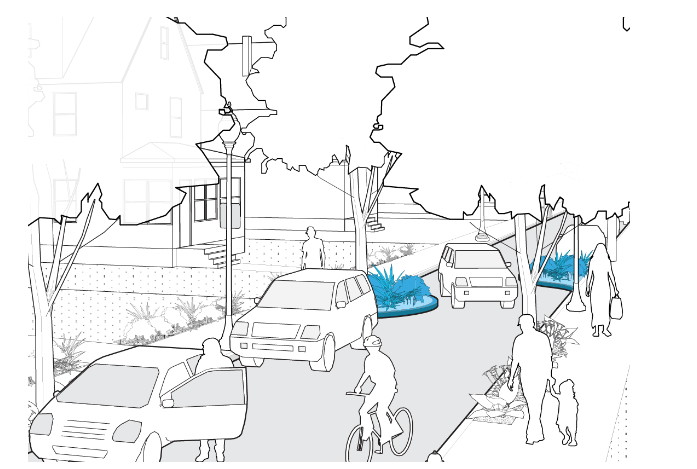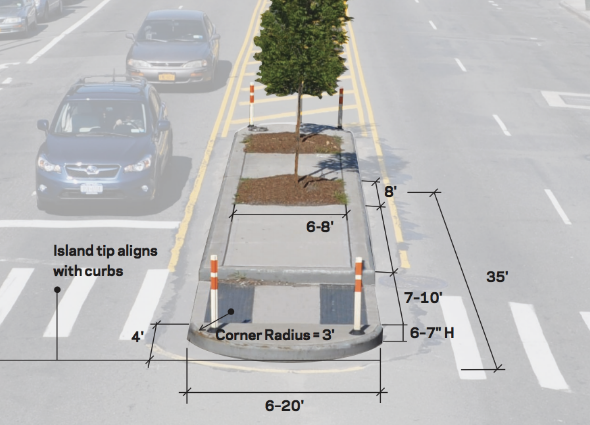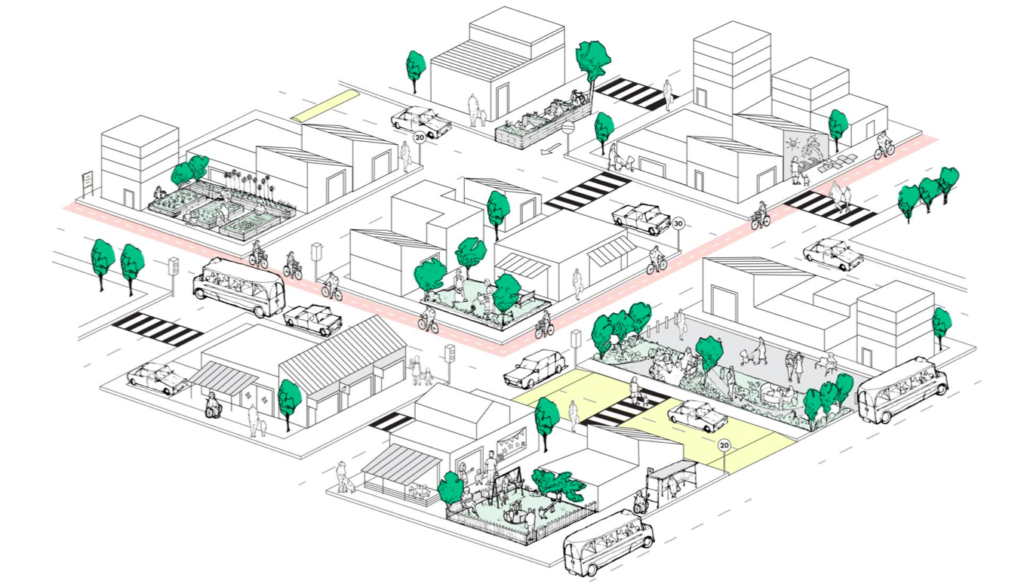
Street design
We tend to take our streets for granted. The lanes and the signals and the signs, they really hold the keys to our economy and safety and the livability of streets.
Janette Sadik-Kahn
Street design is the most powerful tool to support safe walking, cycling, public transport, and driving. Swedish research suggests that improving education, information, and enforcement have only a marginal effect on reducing crashes. By addressing children’s mobility, street designers have an opportunity to make walking and bicycling safer and more accessible for all, including children, seniors, and people with disabilities.
Streets designed for kids encourage safe movement and social interaction. A network of connected child-friendly streets and public spaces enable children’s ability to safely move by foot or cycle in their neighborhood without an adult. Child-friendly streets take into account their limited range, slower speeds, limited visibility, and unpredictable behaviour. This may entail shorter block lengths, shorter pedestrian crossings, and better sight lines at intersections. To avoid exclusionary design, streets should incorporate universal design principles.
Safe streets ensure that even the youngest users can move around safely and with autonomy. For older children, this allows some level of independence from adults. Safer streets will help increase the number of children who choose to walk and bicycle to school and other destinations. On a broader level, children’s mobility programs can enhance health and well-being, ease traffic congestion near schools and parks, improve air quality and improve community members’ overall quality of life.
5 KEY LESSONS
1. Avoid exclusionary designs
Designs should recognize that children and adults experience streets and public spaces differently and integrate principles of universal design.
2. Create streets for play
Play streets reduce the speed and volume of motor vehicle traffic on local streets to create new public places where children can play.
3. Develop and connect children’s priority zones
Children’s safety priority zones are areas located around children’s playgrounds, parks, schools, churches, and community centers that require special attention to pedestrian safety.
4. Implement rapidly
Transform streets through low-cost interim strategies. Prototype interventions quickly, test their effectiveness, and then implement permanently.
5. Standardise street designs
Develop street design guidelines to ensure consistent implementation across multiple contexts.
Best practices
Footpaths require sufficient clear width for pedestrians and an appropriate arrangement of elements such as trees, utility boxes, light poles, and other types of street furniture to facilitate passage. The safest and most accessible spaces for pedestrians are unobstructed, continuous, shaded, and well lit. Footpaths should be wide enough to prevent crowding and should consist of three zones:
- The frontage zone provides a buffer between street-side activities and the pedestrian zone and should be 0.5 to 1 m wide. Frontage zones should provide space for shops to display their goods, and furniture zones should provide space for plantings, benches, parking meters, vending, and parking.
- The pedestrian zone provides continuous space for walking. The pedestrian zone should be clear of any obstructions, level differences, or other obstacles to pedestrian movement and should have a clear width of at least 2 m, and wider as volumes dictate.
- The furniture zone offers space for landscaping, furniture, lights, bus stops, signs, and private property access ramps.


Case Study: Changsha Child Friendly City demonstration projects
The United Nations Children’s Fund (UNICEF) launched the Child Friendly City (CFC) program in 1996 during Habitat II with the aim of making cities liveable, especially for children. The City of Changsha became the first CFC in China. Since June 2016, the Changsha Urban Planning Bureau has worked in partnership with local design institutes and the Institute for Transportation and Development Policy (ITDP) to develop plans for high quality child friendly interventions across the city. The results include ten demonstration projects that have transformed the environment around schools. These improvements consist of walking spaces, crossings, traffic management, transport infrastructure, and public spaces around schools, all aiming to establish a better environment for children to study, live, and play.
Children participated extensively in the planning process. “Pinpoint mapping” let students and families map home locations, home-to-school routes, and resting points. The project also circulated questionnaires to students and parents to gather information transport modes, time, cost, and need. During a “places by feeling” exercise, children drew places where they feel safe and scared. “Wish stickers” allowed first to fifth graders from the ten pilot schools to identify their desires for playgrounds, walkways, and parks on the way home. “Little planner” drawing activities and exhibitions and a CFC Open Class also sparked discussion and media attention. The Changsha CFC project won the 2017 CFC Community Service Projects Award in China and inspired replication in other Chinese cities including Shenzhen.

Cycle tracks are designated spaces within the street specifically for the movement of cyclists. Providing dedicated cycle infrastructure is essential to accommodate cyclists of all ages, abilities, and confidence levels. Cycle infrastructure should provide a comprehensive, safe, and low-stress network of recommended routes to and fro children or youth friendly areas.
Physical separation of cycle facilities is especially important. Separation is most effective when facilities are separated by a curb, barrier, raised median, or grade difference, protecting cyclists from motorized vehicles and preventing other users (such as motorized two-wheelers, or parked vehicles) from infringing on the dedicated bicycle infrastructure. Cycle tracks should be at least 2 m wide for one-way movement.

Speed humps
Speed humps are raised pavement that can reduce speeds to a certain limit based on the height and length of the hump. Humps are artificial elevations on the roadway. A hump is often designed as part of a circle, a trapeze, or as a sinusoidal curve. Speed humps can be designed for different target speeds, and are not limited to low traffic streets. Ideally, speed humps will enable vehicles to travel at a target speed consistently along a road, rather than slowing down and speeding up before and after each hump.
Speed cushions
Speed cushions are traffic calming devices designed as several small speed humps installed across the width of the road withs paces between them. Speed cushions force cars to slow downbut are different from a speed hump as they can better allow movement of larger vehicles – such as buses or ambulances – by straddling the cushions. Speed Cushions to support children’s health and mobility.

Chicanes
Chicanes are artificial turns created to slow traffic. They lead to a reduction in the width of the roadway, either on one side or on both sides or constructed in a zigzag, staggered pattern that directs drivers away from a straight line, which can reduce vehicular speeds on both one- and two-lane roads. Chicanes to support children’s health and mobility.

Pedestrian refuge islands
Pedestrian refuge islands are waiting areas in the right-of-way for people crossing the street that provides some physical protection from vehicles. They reduce the time pedestrians are exposed or vulnerable to vehicles while crossing an intersection. Safety islands are most beneficial at locations where speeds and volumes make crossings prohibitive, or where three or more lanes of traffic make pedestrians feel exposed or unsafe in the intersection. Safety islands should include wide curb ramps or cut-throughs to accommodate users of mobility devices and people who have difficulty climbing curbs, including smaller children and people with strollers. Safety islands should include curbs or bollards, and extend past the crosswalk in order to physically separate and protect people waiting from vehicles. Refuge islands at intersections can have the added benefit of slowing down turning drivers.

Intersection retrofits seek to improve safety by lowering motor vehicle speeds and reducing crossing distances. A common technique is to install kerb extensions that narrow the roadway and provide additional pedestrian space at corners. Kerb extension reduce vehicle turning speeds, visually narrow the roadway, and improve visibility of pedestrians. This is particularly beneficial for children who are shorter-stature and therefore may be less visible at intersections to drivers. The shorter crossing distance also makes it easier for slower-moving children, and others with limited mobility, to safely cross the street during the pedestrian signal phase. Curb extensions can often be lengthened to create public spaces, landscaped areas, or public transport waiting areas.

Case study: Addis Ababa Intersection Transformation
Street design in Addis Ababa has long prioritized vehicle speed over pedestrian safety. Car-oriented streets feature wide lanes, large turning radii, and no sidewalks, crossings or other traffic calming features. LeGare intersection in particular has been a hotspot for traffic violence. It has high pedestrian volumes, but misaligned traffic lanes, inadequate street markings and signage, and poorly timed signals encourage dangerous motorist behavior.
In 2016, the Global Designing Cities Initiative (GDCI) initiated a temporary “pop-up” intervention to train local stakeholders in tactical urbanism design and implementation strategies. For the new intersection design:
- Tight corner radii require drivers to slow their speeds to make sharper turns.
- Direct crosswalks help shorten pedestrian crossing distances and reduce exposure to traffic.
- Realigned crosswalks match existing pedestrian patterns and make pedestrian behavior more understandable to motorists.
- Pedestrian refuge islands and medians shorten crossing distances and provide safe waiting spaces for those crossing the street.
- Under-utilized road space is given over to pedestrians to manage vehicle behavior.
- Aligned vehicle lanes ensure that traffic moves smoothly and in a way that is predictable to pedestrians and other road users.


Assessment of the performance of the interim safety interventions drew the following conclusions:
- Pedestrian behavior: After the transformation, the number of pedestrians complying with traffic signals slightly increased 8 percent, while crosswalk compliance increased 13 per cent.
- Driver Behavior: Tightened turning radii helped reduce average turning speeds at LeGare from 11.5 to 18.5 km/h.
- Public Perception: After the transformation, around 52 per cent of respondents assessed the quality of infrastructure as ‘very good,’ up from 41 percent before the intervention.
The LeGare intersection intervention demonstrates that simple design interventions can powerfully change the way pedestrians, cyclists, and motorists interact with the street environment. This is an important finding for Addis, as pedestrian safety improvements are very cost effective. The typical cost of a vehicle underpass is ETB 200 million, and a pedestrian bridge costs around ETB 10 million. The LeGare intersection intervention cost less than ETB 400,000. The difference is striking: The cost of a single pedestrian bridge could fund 25 intersection improvements and deliver more positive safety outcomes for pedestrians.
School zones must be designed to provide seamless pedestrian connectivity, so children can travel free from risk of crashes with motor vehicles. School areas should offer safe, at-grade pedestrian access, employing universal design techniques that ensure accessibility for all students. Well-designed crossings allow children to cross busy streets safely and conveniently, ideally without adult supervision.
At-grade crossings are the preferred type of crossing for most school areas because they offer safety, convenience, and universal access. At-grade crossings should be designed per the following guidelines:
- A raised crosswalk that is at least 2.4m wide, elevated to the level of the adjacent footpath (150 mm above carriageway), with a speed table for motor vehicles. The slope for vehicles should be at least 1:8.
- Pedestrians should not have to cross more than two lanes of traffic before reaching a pedestrian refuge. On streets with more traffic lanes, signalised crosswalks should be provided (see Pedestrian Signals). Per the present designs, the carriageway will have a width of 7.3m for two lanes of mixed traffic. Reducing the carriageway width to 6.0-6.5 m can help reduce mixed traffic speeds and minimise the distance that pedestrians need to cross.
- Speed bumps in mixed traffic lanes in advance of pedestrian crossings can help further reduce motor vehicle speeds.


Case study: School Area Road Safety Assessment and Improvement
AMEND’s School Area Road Safety Assessment and Improvement (SARSAI) program tackled road safety at the highest-risk schools in the highest risk cities in the highest risk countries in the world. SARSAI involves a systematic assessment of areas around schools, identification of measures that will improve road safety, and the implementation of those measures by the NGO and local authorities. At schools where injury rates among student population are over 4 per cent per year, the program supported relatively low-cost infrastructure improvements to slow traffic and separate pedestrians from traffic. Improvements implemented included: speed bumps, bollards, sidewalks, signage, new school gates, and others. The program also introduced community-based measures such as crossing patrols, and community / school road safety education.
AMEND is currently conducting an impact evaluation of SARSAI with the US Centers for Disease Control and Prevention and researchers from the Johns Hopkins School of Public Health at catchment areas around 18 primary schools in Dar es Salaam, Tanzania. Preliminary results indicate the interventions led to a reduction in the number of crashes and injuries during the morning hours.
Best to avoid: Grade-separated Crossings
Many cities attempt to provide crossings in the form of footbridges or subways. However, grade-separated pedestrian crossings have numerous drawbacks:
- Increased travel time. Footbridges lead to circuitous walking routes that typically increase travel distances and times, thereby discouraging walking. Pedestrians typically seek out short, direct routes to their destinations, and may opt to bypass the footbridge and cross unsafely at-grade.
- Lack of universal access. Footbridges with steps or steep ramps are often inaccessible and increase barriers to persons with disabilities, people carrying luggage, parents with strollers, and young children. Extensive ramping may be installed to accommodate wheelchairs and bicyclists, but long distances and steep slopes still discourage use.
- Obstruct footpaths: Footbridge entrances and support columns can sometimes block footpaths. In order to accommodate both footbridges and footpaths, cities may need to acquire land outside the public right-of-way (ROW), which can be expensive.
- Prohibitive cost. Footbridges cost upwards of twenty times as much as at-grade crossings.
- Harassment and general crimes. Grade-separated facilities are by definition removed from street-level activity and the passive security it provides. The walking environment in these facilities is generally poor and potentially unsafe with regard to sexual assault, eve teasing, and general crimes, especially during night-time hours.
- Increased vehicle speeds. Grade separation also tends to increase motor vehicle speeds, further degrading the overall walking environment in the vicinity of the footbridge or subway.


Safe school zones should be developed around each elementary school to improve safety and expand opportunities for play. School zones typically include speed restrictions to 30 km/h or below within a 200 m radius of the school as well as traffic calming elements to ensure that vehicles follow the speed limit. Traffic calming elements are most effective at slowing vehicle speeds when several measures are implemented together. In addition signs indicating school zone presence, pedestrian crossings, and speed limits should be installed to remind drivers to treat the area with special care and attention. School zones can improve upgraded links to playgrounds, parks, schools, and community centers that require special attention to pedestrian safety.

Play streets are interventions that transform streets into places for children to play. They offer a low-cost way for neighborhoods and schools to reimagine more people-oriented spaces. Play streets create more space for active recreation, which can be especially helpful for schools with limited or no access to a gymnasium, multi-purpose space, or outdoor recreation facilities. Supporting inclusive play alongside the needs of elderly people will result in tangible health and well-being benefits for the whole community.
Play streets can be temporary or permanent interventions. In cases of short-term interventions, local, typically low-volume streets are closed for a specific portion of the afternoon and/or weekend for play and recreation. These programs typically are sponsored by schools or local community organizations, while partnerships with municipalities can support play equipment and activity programming (e.g., dance classes, art-making events, and sporting workshops).

Pedestrian-oriented street lighting is a key streetscape element that defines the nighttime visual environment in urban settings. Quality street lighting contributes to a positive urban character, supports nighttime activities, and is critical for both traffic safety and pedestrian safety and security. Pedestrian focused illumination mounted less than 5.5 m high is critical for areas such as sidewalks, shared public ways, public stairways, and other pedestrian paths. Pedestrian lighting should be provided on high pedestrian volume corridors or where a special design treatment is desired to supplement roadway lighting. Pedestrian lighting should be consistent throughout a block and minimize variance between bright and dark areas.

There are many types of urban road networks. However, the key to mobility for NMT users is a high ratio of intersection nodes to road links so that streets and pathways are well connected. The maximum recommended block size for people friendly streets is 100 m. Prioritised connectivity creates finer grained networks for walking, including pedestrian-only streets. A fine-grained walking and cycling network helps to reduce trip distances and improves access to public transport.

Case study: Khayelitsha Urban Space Transformation
The Khayelitsha Urban Space Transformation project upgraded a network of informal walkways to create high-quality pedestrian links and public spaces. Through the project, the City of Cape Town sought to accomplish the following goals:
- Provide a clear definition between public and private spaces.
- Provide places for play and relaxation.
- Create a safe, well-lit, and easily surveyed pedestrian route.
- Employ sustainable landscape practices.
- Use easy-to-maintain, durable materials and designs.
Between 2006 and 2013, the project used participatory design and development with local leadership and relevant municipal departments. Community participation informed the design of various components of the spaces. This enabled community participation, skills transfer, and ongoing work opportunities for the maintenance of the new public spaces.Local pride, involvement, and stewardship were fundamental in reducing vandalism and urban violence, transforming the use and perception of the space. Ultimately, the project team transformed a high-crime area into a sustainable, multifunctional public space.


Street design manuals provide a design guide for planners, consultants, engineers and advocates to improve the walkability and bikability of roadways within their communities and create more safer streets for users of all ages and abilities. The street design manuals also provides consistency to the design of bicycle and pedestrian facilities. communities
Case study: Johannesburg Complete Streets Design Guideline
The City of Johannesburg Complete Streets Design Guideline is a comprehensive resource covering the design of pedestrian, bicycle, and public transport facilities. The manual includes typical construction details for tabletop crossings, kerb ramps, tree pits, bicycle parking, and other street elements. The Guideline also indicates how these elements should be combined on streets with different sizes and functions.
Resources
Alta Planning + Design. Reducing speeding-related Crashes through Design
Bernard Van Leer Foundation. Mix & Match: Tools to design Urban Play
FIA Foundation. Speed kills Children. Use the Vaccine. #SlowDown
Global Designing Cities Initiative. Global Street Design Guide
ITDP. Streets for Walking and Cycling
ITDP. Better Streets, Better Cities
